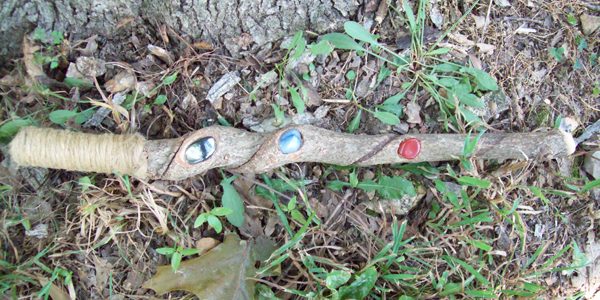
 The Witch’s Guide to Wands: A Complete Botanical, Magical, and Elemental Guide to Making, Choosing and Using the Right Wand, by Gypsey Elaine Teague
The Witch’s Guide to Wands: A Complete Botanical, Magical, and Elemental Guide to Making, Choosing and Using the Right Wand, by Gypsey Elaine Teague
Weiser Books, 9781578635702, 256 pp. (incl. appendixes and index), 2015
“The wand chooses the witch, the witch does not choose the wand.”1 This book opens with this statement, which at once makes the reader question the need for a “guide to wands” (as one is likely to expect it), and also reinforces their power and allure as a magical tool. In The Witch’s Guide to Wands, Gypsey Elaine Teague shares a glimpse into the world of wands, showing the wand as the small, but potentially transformative, tool.
Teague, who is a writer, craftswoman, and elder, provides information about the unique purposes of wands made of various types of woods, vines, grasses, and metals. She shares background information about the source (it’s role in myth and historic use), the magical strengths of each, and anecdotes of her personal experiences with some. The book concludes with appendixes of wands listed by use — ideal types for creativity, protection, hallucination, etc. and the gods and goddesses, sexual energies, and elements associated with each.
New practitioners will likely appreciate how accessible the information here is. Teague writes with the voice of an instructor or guide helping the reader to gain the background knowledge necessary to find the right wand. For example, she suggests which types of practitioners could benefit from which type of material, and how they might use a wand made from it: “The mimosa wand is very good for dancers and those who wish to connect with their spirit of movement. Cast a circle with the mimosa want and then practice whatever routine you may have within the circle. The energy from the wood will carry you to new heights in your dance [and] gymnastics.”2
In addition to offering several different ways to use the certain types of wands, Teague shares how to go about finding a wand — keeping in mind that the wand chooses the witch — what it means, and what will that “look like.” She explains by sharing her own story of how her first wand chose her:
“First wand,” the blonde woman mused. “We must offer a good selection then.” She began placing long velvet wand bags across her table, covering almost five feet of the counter… “Place your hand over the bags,” the blonde instructed. “Pass your hand over each until the wand that is yours tells you… you’ll know when it’s right.”
The teenager began at her left and passed her right hand over each bag, holding it there for a few seconds and then continuing. “I’m getting nothing from these,” she said softly. When the field was down to six bags, the girl began again. Slowly, and this time more deliberately, she passed her hand over each bag. Finally she stopped and pointed. “This one.”3
Teague compares the right wand to your favourite pair of jeans or shoes or your little black dress — when it’s right, it’s right, and you just know it.4
Some wand basics that might help the reader to supplement their intuition are also covered, including how long most authors believe a wand should be (14 inches),5 there’s to be a positive end and a negative end (like a battery), not all wands should be composed of a single material (to Teague’s mind, “If you must have two or three traits for a spell, then why not turn a wand out of two or three different woods?”),6 and you probably don’t want to buy one online, instead, you should “find a wand maker you trust, and then allow your wand to find you.”7
To reinforce this last point, Teague shares a behind-the-scenes look at what it takes for her to make a wand from a piece of raw material and turn it into a tool capable of casting energy out and in. She makes sure the wood is cut, purchased or donated with reverence. Before getting to work, she casts a circle to begin the creative process. When she’s done, she’ll place finished wands in it’s own bag for storage — there is no outside influence in the process. These are all energies a shopper is likely to sense when looking at wands in person. Meeting the maker will help, too.8
Harry Potter fans will be interested to see a small chapter dedicated to the wands of J.K. Rowling. Teague takes the reader back to Garrick Ollivander in Diagon Alley to consider the three wands Harry is presented with upon his visit — maple, beech, and ebony — and the fourth, which ends up choosing him, holly. We also consider Ron’s wands (ash, willow), Hermione’s (vine), and Hagrid’s (oak), and other tertiary characters, and see what energies these wands bring to each characters’ magical journeys.
This is a helpful reference to have on hand if you’re interested or active in using ritual tools. In writing about wands, Teague shares a lot more information beyond the tool itself. The Witch’s Guide to Wands will give the reader a sense of how a wand could fit into their larger practice, and is likely to offer new ideas for practitioners of all levels of experience.
Image credit: DragonOak








